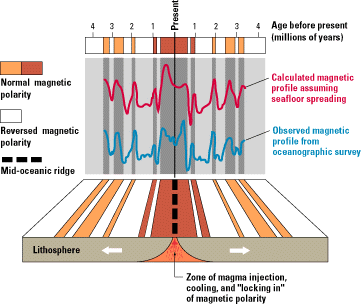
Plate Tectonics |
||
WWII ends, and Harry head back to Princeton, where he begins to study data & continued researching guyots and mid-ocean ridges. He used all of the data listed above, and, slowly, began to put the pieces of the puzzle together. Most of his data didn't really make sense - until Tharp and Heezen's 1953 Great Global Rift report was published.
In his 1962 US Navy Report (History of Ocean Basins), Hess proposed his ideas for Sea Floor Spreading. In a nutshell, his ideas include the following:

Image source: Sonjia Leyva, own work, © 2020.
But, what is causing everything to move? Hess developed an idea that seafloor spreading is driven by convection cells in the mantle. It took a while for science to catch up to this idea, however.
Hess looked at the distribution of earthquakes at ridges and subduction zones. He noticed that there was a pattern to where they were located. Shallow earthquakes were concentrated at rift zones, while deep-focus earthquakes were located next to trenches. There were very few earthquakes in the interior of continents.
Watch this PacificTCW video, A Decade of Great Earthquakes. This video shows all the >3 M earthquakes for a 10 year period between 2004-2014. While watching it, note the following:
The discovery of the "Great Global Rift" caught the attention of many scientists in addition to Harry. They noticed that the heat flow was highest at the ridges, and decreases away from the ridges.
Note on the image below that the black lines indicate a plate boundary, and that the dark red lines (representing the highest heat flow) are adjacent to the mid-ocean ridges.

Image Source: "Global heat-flow map derived from mixed data sets" by V. M. Hamza, R. R. Cardoso, C. H. Alexandrino ,
Researchgate.net is licensed under CC BY 3.0
Other scientists were studying the age of the crust on the seafloor and the sediments. They discovered that radiometric dating shows the oldest crustal rocks on seafloor as 200 million years old. However, the scientists also knew that the radiometric age of continental rocks was around 4 billion years old. What happened to all of the older rocks?
Hot mantle material rises to the surface and is erupted at the mid-ocean ridge. This new rock is young and hot, It gets pushed aside as new rock erupts to the surface. Over time, the erupted rocks move further and further away from the spreading center, getting old and colder as they do.
The map below was made using data from cores drilled into the oceanic crust. Red indicates the youngest rocks, which are found at the axis of the mid-ocean ridges, and dark blue the oldest, located either at the edge of the continents or at a subduction zone.

Image source: "Scientific drilling of the oceanic lithosphere, 1968-2003" by , Ocean Drilling Program is in the Public Domain
Seafloor sediments proved to be a puzzle, too. Studies showed that sediments became older the further away they were from the ridges. Sediments at the axis of the ridges were young and thin, and they got older and thicker the further away they were from the axis.
Lastly, people started to look at the odd results sailors were recording on the magnetometers. Instead of a flat line until a spike formed when an iron-bearing object was located, the line went up and over, then down and over, then up and over, all across the seafloor. This was due to the fact that the Earth’s magnetic field reverses, and this change is recorded by iron minerals in rocks.
Note the animation below on the right. When magma erupts at the mid-ocean ridges, the iron-bearing minerals become magnetized with the Earth's polarity. This newly formed rock gets pushed aside as new rock is formed, one side moving apart from the other to form two 'stripes' on either side of the ridge. This process continues and the seafloor spreads wider, with each generation of rock imprinted with what's happening with Earth's magnetic field.

Image source: "East Pacific Rise seafloor magnetic profile - observed vs calculated" by, USGS is in the Public Domain

Image source: "Sea-floor spreading and magnetic anomalies." by , Houghton Mifflin Company is licensed under CC BY-NC 4.0
To sum all of this up: Hot magma erupts to the surface at the mid-ocean ridge, where it cools. At this point, the newly formed rocks are brand-new (young), very hot, are imprinted with the Earth's current polarity, and have very little sediment covering them. This rock gets shoved aside as new rock erupts to the surface, one half on the left of the spreading center, one to the right. Over time, each side gets pushed further and further away from the axis of the spreading center. As it does, it gets older, colder, and the sediment layer on top of it gets thicker and thicker.
copyright Sonjia Leyva 2022 |
|